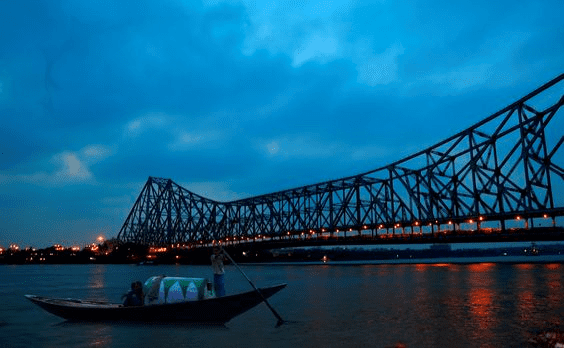A bridge type supported by cables hung from towers or pylons is referred to as a suspension bridge. The cables anchored at both ends of the bridge support its deck. Steel wires are used to create the cables, which are weaved together to create a sturdy, elastic rope. Made of steel or concrete, the bridge deck is suspended from the cables by vertical suspender cables or chains.
Suspension bridges are used frequently to cross rivers, gorges and other wide gaps as they are built to span large distances. Owing to their lightweight construction, they don’t need many piers or supports.
See also: What is truss bridge and why is it important?
Suspension bridges in India
Suspension bridges in India are known for their architectural and engineering designs.
Howrah Bridge

Source: Pinterest
The Howrah Bridge in Kolkata crosses the Hooghly River. One of the busiest bridges in the world, construction of this bridge was completed in 1943.
Bandra-Worli Sea Link

Source: Pinterest
This 5.6-km-cable-stayed bridge links Mumbai’s Bandra and Worli neighbourhoods. It was completed in 2009.
Mahatma Gandhi Setu

Source: Pinterest
The 5.5-km-long Mahatma Gandhi Setu spans the Ganges River between Patna and Hajipur in Bihar. The bridge was built in 1982 and is one of India’s longest river crossings.
Vidya Sagar Setu

Source: Pinterest
The Hooghly River is crossed by the Vidyasagar Setu, which links Kolkata and Howrah in West Bengal. The construction of this bridge was completed in 1992 and named after Ishwar Chandra Vidyasagar.
Suspension bridges: Advantages
- Lightweight construction: Suspension bridges are constructed using less material because of their lightweight form. They are also simpler and more affordable to build as a result.
- Flexible: Suspension bridges have flexible structures that enable them to survive powerful winds and earthquakes. Reduced stress on the bridge structure is achieved by designing the cables and deck of the bridge to sway with the wind or ground movement.
- Better navigation: Suspension bridges feature a high clearance from the water’s surface, which improves navigation and lowers the possibility of running into boats or ships.
- Unique designs: Because of the distinctive designs of suspension bridges, these are landmarks in many cities worldover and frequented by tourists.
- Cost-effective: As suspension bridges need fewer piers or towers, they can be built for lesser cost than other long-span bridge types like cable-stayed or arch bridges.
FAQs
What are the features of a suspension bridge?
A suspension bridge covers vast distances. The sleek and light-weight design that they sport, helps them to traverse wide rivers and narrow valleys.
What materials are used in the construction of the suspension bridges?
Steel wires are woven together to create a strong, flexible rope that serves as the foundation for the suspension bridge cables. The steel or concrete is used to construct the bridge deck.
| Got any questions or point of view on our article? We would love to hear from you. Write to our Editor-in-Chief Jhumur Ghosh at jhumur.ghosh1@housing.com |






